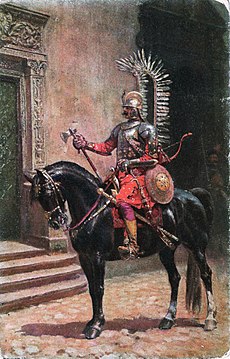
Back هوسار بولنديون Arabic Гусарыя Byelorussian Гусарыя BE-X-OLD Polští husaři Czech Hussaria German Húsares alados polacos Spanish هوسارهای لهستانی Persian Ussari alati di Polonia Italian ფრთიანი ჰუსარები Georgian 폴란드 후사르 Korean
| Polish hussars | |
|---|---|
 | |
| Active | 1503–1702 (disbanded in 1776) |
| Allegiance | |
| Type | Heavy cavalry |
| Role | Maneuver warfare Raiding Shock attack |
| Nickname(s) | The Angels of Death[1] |
| Motto(s) | Amor Patriae Nostra Lex (Love of the fatherland is our law) |
| Colors | Red and white |
| Equipment | Burgonet, lance, mace (bludgeon), hatchet, sabre |
| Engagements | Tree list
|
The Polish hussars (/həˈzɑːrs/; Polish: husaria [xuˈsarja]),[a] alternatively known as the winged hussars, were a heavy cavalry formation active in Poland and in the Polish–Lithuanian Commonwealth from 1503 to 1702. Their epithet is derived from large rear wings, which were intended to demoralize the enemy during a charge. The hussars ranked as the elite of Polish cavalry until their official disbanding in 1776.
The hussar dress was ostentatious and comprised plated body armour (cuirass, spaulders, bevors, and arm bracers) adorned by gold ornaments, a burgonet or lobster-tailed pot helmet and jackboots as well as versatile weaponry such as lances, long thrusting swords, sabres, pistols, carbines, maces, hatchets, war hammers, and horseman's picks. It was customary to maintain a red-and-white colour scheme, and to be girded with tanned animal hide. The wings were traditionally assembled from the feathers of raptors, and the angel-like frame was fastened onto the armour or saddle.
The early hussars were light cavalry units of exiled Serbian warriors who came to Poland from Hungary as mercenaries in the early 16th century. Following the reforms of King Stephen Báthory (r. 1576–1586), the Polish military officially adopted the unit and transformed it into heavy shock cavalry, with troops recruited from the Polish nobility. The Polish hussar differs greatly from the light, unarmoured hussars that developed concurrently outside Poland.
The hussar formation proved effective against Swedish, Russian, and Ottoman forces, notably at the battles of Kircholm (1605), Klushino (1610), and Khotyn (1673). Their military prowess peaked at the Siege of Vienna in 1683, when hussar banners participated in the largest cavalry charge in history and successfully repelled the Ottoman attack. From their last engagement in 1702 (at the Battle of Kliszów) until 1776, the obsolete hussars were demoted and largely assigned to ceremonial roles.
Cite error: There are <ref group=lower-alpha> tags or {{efn}} templates on this page, but the references will not show without a {{reflist|group=lower-alpha}} template or {{notelist}} template (see the help page).
© MMXXIII Rich X Search. We shall prevail. All rights reserved. Rich X Search